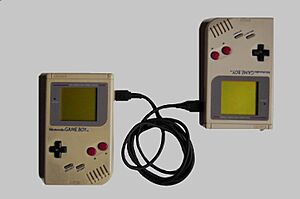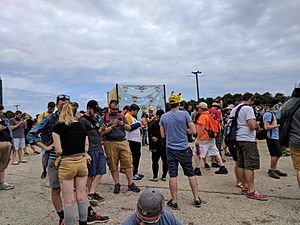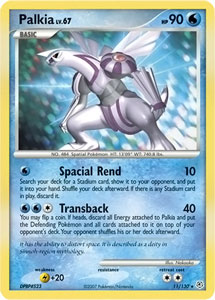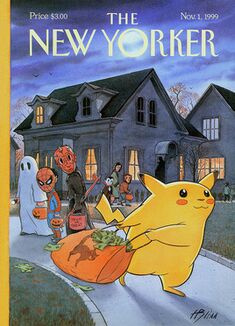Pokémon facts for kids
Quick facts for kids Pokémon |
|
|---|---|

International franchise logo, designed by Chris Maple in 1998
|
|
| Creator | Satoshi Tajiri |
| Original work | Pocket Monsters Red and Pocket Monsters Green (1996) |
| Owner | |
| Print publications | |
| Comics | See list of Pokémon manga |
| Films and television | |
| Films | See list of Pokémon films |
| Animated series | Pokémon (1997–present) |
| Games | |
| Traditional | Pokémon Trading Card Game |
| Video games | Pokémon video game series |
Pokémon is a popular Japanese entertainment series. It includes video games, animated TV shows and movies, a card game, and more.
The world of Pokémon features special creatures called Pokémon. Humans and Pokémon live together in this shared world. The series is popular with people of all ages. Pokémon is thought to be the world's highest-earning entertainment series. It is also one of the best-selling video game series.
The idea for Pokémon came from Satoshi Tajiri. He created it as a pair of role-playing games for the Game Boy. These games came out in Japan in 1996. They became very popular and led to manga comics, a card game, and an anime TV show. From 1998 to 2000, Pokémon became a huge global hit, known as "Pokémania." Even after this craze, Pokémon stayed popular. New products are still released today. In 2016, the game Pokémon Go started another big craze. This game uses augmented reality to let you catch Pokémon in the real world.
Pokémon is owned by three companies: Nintendo, Game Freak, and Creatures. Game Freak makes the main video games. Nintendo publishes these games for their consoles. Creatures handles the card game and other products. In 1998, these three companies created the Pokémon Company (TPC). This company manages Pokémon in Asia. Since 2009, The Pokémon Company International (TPCi) has managed Pokémon everywhere else.
Contents
- What Does Pokémon Mean?
- How the Pokémon World Works
- The History of Pokémon
- Pokémon Media
- Reactions to Pokémania (1999–2000)
- What Pokémon Left Behind
- See also
What Does Pokémon Mean?
The original full name of the series is Pocket Monsters. This was shortened to Pokémon in Japan. When the series came out around the world, the short name was used. The little mark over the "e" (´) helps people say the name correctly.
The word Pokémon refers to both the series itself and the creatures in its world. When you talk about the creatures, the word Pokémon is both singular and plural. So, you say "one Pokémon" and "many Pokémon." This is also true for each Pokémon species, like "one Pikachu" and "many Pikachu."
How the Pokémon World Works
The Pokémon series takes place in a world where humans and creatures called Pokémon live together. The first games, Pokémon Red and Blue, had 151 different Pokémon. New Pokémon have been added in later games. As of January 2024, there are 1,025 Pokémon species. Many Pokémon are based on real animals or mythical creatures. For example, Pikachu looks like a yellow mouse with a lightning bolt tail. It can shoot powerful electric jolts.
You play as a Pokémon Trainer. Your main goals are to explore the Pokémon world, find and catch every type of Pokémon to complete your Pokédex, and train your Pokémon team for battles. You catch most Pokémon using round devices called Poké Balls. When a wild Pokémon is weak enough, you throw a Poké Ball at it. If successful, the Pokémon is caught and becomes yours.
Your Pokémon can battle against wild Pokémon or other Trainers' Pokémon. These battles are not violent. Pokémon do not die in battle; they just faint. You can then heal them at a Pokémon Center.
When a Pokémon wins a battle, it earns experience points. As it gains enough points, it levels up and becomes stronger. It also learns new moves for battles. Many Pokémon can also evolve into stronger forms. Most evolve at a certain level. Others evolve by using a special item or by being traded with another trainer.
The History of Pokémon
How It All Started
The main idea for Pokémon came from Satoshi Tajiri. When he was a child, he loved catching insects and other small creatures in his hometown in Japan. As his town grew, nature was destroyed. When he was a teenager, he discovered video games.
Tajiri later started a magazine about video games called Game Freak. He published the first issue in 1983. Later, Ken Sugimori joined him as an illustrator. Tajiri became a respected video game journalist.
Tajiri met Tsunekazu Ishihara, who was also interested in games. They both knew a lot about the growing video game industry in Japan.
In 1986, Tajiri, Sugimori, and others formed a game development team called Game Freak. They made a puzzle game called Quinty. Junichi Masuda joined them to create the game's music. Game Freak Co., Ltd. officially started in 1989.
Making Red and Green (1989–1995)
Tajiri got the idea for Pokémon while working on Quinty. He learned that Nintendo's new Game Boy handheld console would have a Game Link Cable. This cable would let two Game Boys connect. Tajiri realized players could trade things between games. He combined this idea with his childhood memories of catching insects. He wanted to create a virtual world where players could "regain the world that he had lost." He said the game was "the story of a boy's summer day."
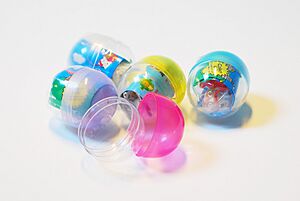
Tajiri and his team imagined a game where players caught creatures of different rarity. These creatures would be stored in small capsules. This idea came from a TV show called Ultraseven, where a hero used capsules to release monsters. Other inspirations included gashapon (toy capsules from vending machines), collectible cards like baseball cards, and having pets in Japan.
Tajiri first named his project Capsule Monsters. But they couldn't trademark that name. So, they changed it to Pocket Monsters, which became Pokémon.
Tajiri presented his idea to Nintendo. Nintendo's president, Hiroshi Yamauchi, liked the idea. He said, "This is it. This is the idea I've been waiting for."
Development for Pocket Monsters began in 1990. Tajiri directed the project, and Ishihara was the producer. Sugimori designed the graphics and characters. Masuda created the music and sounds. The team realized the game was harder to make than they thought. Development slowed down for a few years.
In 1994, Tajiri decided to focus on finishing Pocket Monsters. The team had more experience by then. Atsuko Nishida, a graphic artist, joined and created Pikachu. Ishihara helped improve the battle system and came up with the idea for the Pokédex.
Shigeru Miyamoto, a top Nintendo game designer, suggested making two different versions of the game. This way, players would need to trade with each other to collect all the Pokémon. They decided on Red and Green versions. Each version had some Pokémon not found in the other.
Pocket Monsters Red and Green were finished in December 1995. They were released on February 27, 1996. The copyright notice on products still shows "©1995" because the property was copyrighted that year.
Pokémon's Rise in Japan (1996–1998)
Nintendo did not expect Pokémon Red and Green to be huge hits. The Game Boy console was already old. However, the Game Boy was still widely used and affordable for children.
The CoroCoro Comic magazine played a big role in Pokémon's success. It was read by many elementary school students. The magazine's deputy editor, Masakazu Kubo, suggested making a manga comic based on the game. The first chapter came out the day after the games were released.
To promote the games, CoroCoro announced the "Legendary Pokemon Offer" in April 1996. Readers could enter a lottery to get the secret Pokémon, Mew, uploaded to their game cartridge. This lottery was very successful and helped spread the word about Pokémon. By September, Red and Green had sold over 1 million copies.
Game Freak also created Pokemon Blue. This version was originally for bug fixing and training new staff. It was not meant to be sold. But Kubo convinced Tajiri and Ishihara to release it. It was offered through mail order as a special edition. It sold more than double what was expected.
The Trading Card Game
The Pokemon Trading Card Game (PTCG) was one of the first collectible card games (CCGs) in Japan. It was inspired by Magic: The Gathering. Ishihara, who loved card games, designed the PTCG.
It was hard to find companies to distribute the cards at first. Nintendo agreed to make the cards. Media Factory agreed to distribute them.
CoroCoro magazine announced the card game in November 1996. It came with two special cards: Jigglypuff and Pikachu. The first card set was released on October 20, 1996. Booster packs with random cards were also launched. The cards were an instant success. By March 1997, 87 million Pokémon cards had been shipped in Japan. This number grew to 499 million by March 1998.
The Anime TV Show
By August 1996, Kubo believed Pokémon should have an anime TV show. Nintendo and Ishihara were unsure at first. They worried it might make the series less popular if it ended too soon. Kubo promised the anime would last at least a year and a half. This was a big commitment. Nintendo of Japan had never licensed a TV series before. The show was approved in September 1996.
OLM, Inc. was chosen to animate the show. Kunihiko Yuyama became the director. The team of writers and animators were all very experienced. Tajiri insisted that every anime team member play the game. They all enjoyed the game and wanted to make a great show.
A special council was formed to create the anime's world, characters, and story. They wanted the anime to match the video game's world. They decided the main character should start with Pikachu. They thought Pikachu would appeal to both boys and girls, and their mothers. This would help the series reach more people.
The council decided that Pokémon would not speak human languages. They would make their own specific cries, like animals. Ikue Otani was chosen to voice Pikachu. She could make Pikachu's name sound like different emotions.
The Pocket Monsters anime first aired on April 1, 1997. By November, it was the highest-rated show on TV Tokyo. The anime helped more girls become interested in Pokémon. Pikachu became very popular with everyone. This led to the game Pokémon Yellow: Special Pikachu Edition, released in Japan in September 1998. This game was made to look more like the TV show.
Merchandise Expands
As Pokémon grew, many companies wanted to make Pokémon products. Nintendo gave Shogakukan Productions (ShoPro) the rights to approve these products.
A copyright council, led by Ishihara, was formed. They met every week to discuss Pokémon events, publications, and merchandise. Ishihara was very careful about what products were approved. He wanted to protect the Pokémon brand. Most product ideas were rejected to ensure high quality.
By March 1998, 35 companies were making licensed Pokémon goods. There were about 700 different Pokémon products. Tomy made toy figures and plush dolls. Bandai made gashapon and candy. Meiji Seika made chocolate snacks. Many Japanese companies benefited greatly from Pokémon's success.
"Dennō Senshi Porygon" Incident
On December 16, 1997, an episode of the Pokémon anime called "Dennō Senshi Porygon" caused a problem. In the episode, bright, flashing red and blue lights appeared. These flashes caused some viewers to feel sick, with headaches, dizziness, and nausea. A small number of children had epileptic seizures. Hundreds of children went to hospitals, but no one died.
The broadcast of Pokémon was stopped. New rules were made to prevent similar events. The anime returned on April 16, 1998. A Pokémon movie, Pokémon: The First Movie, was already being made. It came out on July 18, 1998.
The incident did not harm the Pokémon series. In fact, its popularity continued to grow.
Global Expansion (1998–2000)
Minoru Arakawa, president of Nintendo of America (NoA), was interested in bringing Pokémon to North America. He tested the games on his employees, but they thought it wouldn't work in the US. They believed American kids preferred action games with realistic graphics, not complex Japanese role-playing games. They also thought Pokémon looked too "cute" (kawaii). NoA even considered changing the Pokémon designs to make them look "cooler," but decided against it.
Alfred R. Kahn, CEO of 4Kids Entertainment, believed in Pokémon's potential. He agreed to invest in the anime and licensing rights. Kahn suggested using the name "Pokémon" with the accent mark. Nintendo's president approved the project.
Market research showed American kids didn't like Pokémon. But Arakawa ignored this and put a huge budget into launching Pokémon. NoA and 4Kids planned an "aggressive" marketing campaign.
4Kids handled the localization of the Pokémon anime. They wanted to make it more "Americanized." No national TV station wanted to buy the anime. So, 4Kids decided to pay for the production themselves. They offered the show for free to local TV stations across the country. NoA also helped by buying advertising space. Even with this, many stations were hesitant. But 4Kids eventually got 112 broadcasters to carry the show.
Norman J. Grossfeld of 4Kids came up with the famous slogan, "Gotta catch 'em all!" The Federal Communications Commission (FCC) usually doesn't allow commanding phrases in ads for children. But they allowed this one because catching Pokémon is central to the game. The theme song for the show was written to include this slogan.
All decisions about Pokémon in the West had to be approved by the Japanese copyright council. This included all merchandise.
The Pokémon anime first aired in North America on September 7, 1998. Pokémon Red Version and Blue Version were released three weeks later, on September 28, 1998. The Pokémon Trading Card Game was launched in January 1999. The Game Boy Color was also released in November 1998.
Pokémon also launched in Australia, New Zealand, and various parts of Asia in 1998 and 1999. In Europe, broadcasters were initially unsure. But after its success in America, many international broadcasters became interested. By the end of 2000, Pokémon games were in 70 countries, the anime in 51, and the films in 33. The cards were translated into 11 languages.
Pokémania (1999–2000)
In North America, Pokémon quickly became a huge success. Red and Blue sold 200,000 copies in the first month. By December 1998, the Pokémon anime was the top-rated children's show. Warner Bros. won a bidding war to broadcast Pokémon on Kids' WB. The debut episode became the most watched premiere in Kids' WB's history. Pokémon also became very popular in Europe.
By April 1999, Pokémon was a huge trend in the US, called "Pokémania." There was a big shortage of Pokémon products, especially cards. Stores couldn't keep them in stock. Factories increased production, but demand was still too high.
Nintendo's profits increased by 250% in 1999 because of Pokémon. The series accounted for over 30% of Nintendo's income that year. Pokémon's popularity also boosted sales of the Game Boy.
4Kids Entertainment, which was little-known before, grew thirty times in revenue. Many businesses that got a Pokémon license made a lot of money.
Pokémon: The First Movie came out in North America in November 1999. It was a huge box office success, even though many critics didn't like it. November 1999 was likely the peak of Pokémania in the US. Burger King had a big promotion with Pokémon toys, which also led to supply problems.
Pokémon Gold and Silver games were released in North America in October 2000.
The Pokémon Company and Pokémon USA
In 1998, Nintendo, Creatures, and Game Freak created Pokémon Center Co. Ltd. This company managed special merchandise stores called Pokémon Centers. The first one opened in Tokyo in July 1998. As of January 2024, there are 24 Pokémon merchandise shops in Japan.
After Gold and Silver were released, Ishihara wanted to make a Pokémon movie every year. In October 2000, Pokémon Center Co. Ltd. was renamed the Pokémon Company (TPC). Its goal was to manage Pokémon globally.
In February 2001, Pokémon USA (PUSA) was created as part of The Pokémon Company.
End of the Craze and New Games (2001–2006)
In North America, Pokémania slowed down in 2000. By 2002, the craze was mostly over worldwide.
From 2000 to 2002, Game Freak developed Pokémon Ruby and Sapphire for the Game Boy Advance. Junichi Masuda became the director. Masuda was worried that Pokémon might end. He wanted to keep the series going. They also planned remakes of older games, like FireRed and LeafGreen (2004).
Ruby and Sapphire were released in Japan in November 2002. They introduced 135 new Pokémon, bringing the total to 386. Because of this, the slogan "Gotta catch 'em all!" was changed. It was too hard for new players to catch all the Pokémon from all the games.
In 2005, Pokémon USA took over all licensing and anime localization from 4Kids Entertainment. PUSA also replaced most of the original English voice actors to save money.
New Generations and Pokémon Go (2006–2018)
Generation IV and V
Pokémon Diamond and Pearl were released for the Nintendo DS in 2006 (Japan) and 2007 (North America). These games were designed to use the DS's features, like Wi-Fi. Players could trade and battle Pokémon globally. The games used 2D characters in 3D environments.
Pokémon Platinum was released in 2008 (Japan) and 2009 (North America). It changed elements from Diamond and Pearl to make them "even stronger."
Pokémon HeartGold and SoulSilver were released in 2009 (Japan) and 2010 (North America). These were remakes of Gold and Silver. They aimed to balance old and new content.
In 2009, Pokémon USA and Pokémon UK combined to form the Pokémon Company International (TPCi). TPCi now manages Pokémon outside of Asia.
In Generation V, Pokémon Black and White came out for the DS in 2010 (Japan) and 2011 (North America). These games had better visuals and more 3D graphics. They introduced over 150 new Pokémon. This gave new players a fresh start.
Pokémon Black 2 and White 2 were released in 2012. These were the first direct sequels in the main series.
Generation VI and VII (3D Era)
In Generation VI, Pokémon X and Y were released worldwide for the Nintendo 3DS in October 2013. These were the first Pokémon games released globally at the same time. The games focused on "beauty," "bond," and "evolution." Pokémon could evolve into stronger forms by having a strong bond with their trainers. The games also moved to full 3D graphics.
Pokémon Omega Ruby and Alpha Sapphire were released worldwide in November 2014. These were remakes of Ruby and Sapphire. They used the new 3D graphics and core mechanics from X and Y.
In Generation VII, Pokémon Sun and Moon were released worldwide for the 3DS in November 2016. The developers were inspired by Hawaii for the game's setting. They wanted to show Pokémon as "living creatures." The games changed the traditional Gym mechanic to Island Trials. This deepened the player's connection to the story. The enhanced versions, Pokémon Ultra Sun and Ultra Moon, came out in November 2017.
Pokémon Go
In 2016, Pokémon Go started another worldwide craze. It is a mobile augmented reality game. The idea came from a Google April Fools' Day joke in 2014. Tsunekazu Ishihara and Satoru Iwata turned the joke into a real game. Niantic developed it.
Pokémon Go made a lot of money from in-game purchases. By the end of July 2016, it had earned over $160 million. It quickly became the fastest mobile game to reach $600 million in revenue. Its daily use on Android devices was higher than Snapchat, Tinder, Twitter, Instagram, and Facebook in July 2016.
Pokémon: Let's Go, Pikachu! and Let's Go, Eevee! were released for the Nintendo Switch in November 2018. These games were inspired by Pokémon Yellow. They aimed to introduce new players, especially Pokémon Go players, to the main series. They used similar catching mechanics to Pokémon Go.
Newer Generations and Open World (2019–present)
Generation VIII began with Pokémon Sword and Shield, released for the Switch in November 2019. The games focused on the theme of becoming "the greatest or strongest." They introduced Dynamax / Gigantamax Pokémon, which are giant versions of Pokémon. The games also featured a "wide-open space" for players to explore.
Some older Pokémon were not available in Sword and Shield, which upset some fans. These games were the first Pokémon games to get DLC expansions: The Isle of Armor (June 2020) and The Crown Tundra (October 2020). These added new stories, places, and Pokémon.
In 2020, the COVID-19 pandemic led to a new surge in popularity for Pokémon cards. Many YouTubers and influencers helped this trend. This caused shortages of cards and increased their value. The Pokémon Company responded by reprinting products to help stabilize prices.
Remakes of Diamond and Pearl, called Pokémon Brilliant Diamond and Shining Pearl, were released in November 2021 for the Switch. These were the first main series games made by a different developer, ILCA. They kept the traditional game mechanics.
Pokémon Legends: Arceus was released in January 2022 for the Switch. It is a prequel to Diamond and Pearl. This game changed how players catch Pokémon. You can throw a Poké Ball in real-time to catch them, or battle them first.
Generation IX started with Pokémon Scarlet and Violet, released for the Switch in November 2022. These are the first Pokémon games with a fully open world. They also changed the traditional gym and Elite Four battles. The games allowed up to four players to travel together. Their DLC, The Hidden Treasure of Area Zero, was released in two parts in 2023.
On February 27, 2024, TPCi announced Pokémon Legends: Z-A, set to release in 2025 for the Switch. This game returns to the Kalos region from X and Y.
By 2024, the Pokémon series had earned a total of 100 billion US dollars. This makes it the highest-earning entertainment series ever.
Pokémon Media
Video Games
Pokémon video games come in many types. The role-playing games (RPGs) made by Game Freak are the main series. There are also spin-off games like Pokémon Mystery Dungeon (a dungeon-crawling RPG) and Detective Pikachu (an adventure game). Pokémon games are often grouped into "generations." For example, Diamond and Pearl are Generation 4.
Until 2011, Pokémon games were only on Nintendo's consoles. With the rise of smartphones, the Pokémon Company started making games for mobile phones. The most famous is Pokémon Go (2016), which became a worldwide craze.
As of March 2024, over 480 million Pokémon game units have been sold worldwide.
Trading Card Game
The Pokémon Trading Card Game (PTCG) was one of the first collectable card games (CCGs) in Japan. It was inspired by Magic: The Gathering. In the game, players use a 60-card deck with Pokémon, Energy, and Trainer cards. The goal is to knock out your opponent's Pokémon. Cards have different levels of rarity, from Common to Rare Holofoil (shiny). Rare cards are highly valued by collectors.
As of March 2024, 64.8 billion Pokémon cards have been produced.
Anime TV Series and Films
As of 2025, the Pokémon anime has over 1,300 episodes across 27 seasons. The current season is Pokémon Horizons – The Search for Laqua, which started airing in April 2024. The original anime followed Ash Ketchum and his partner, Pikachu. They stopped being the main characters at the end of season 25. The 26th season, Pokémon Horizons, introduced new main characters, Liko and Roy.
A total of 23 anime films have been released. The most recent is Pokémon the Movie: Secrets of the Jungle (2020). There are also spin-off series, TV specials, and short films starring Pikachu.
Live-Action Works
Detective Pikachu, a movie based on the video game, was released in 2019. A sequel is being made.
A live-action TV show called Pocket ni Boken o Tsumekonde started airing in Japan in October 2023.
Postage Stamps
In 2021, Japan Post released special Pokémon postage stamps. In June 2024, France's postal service also issued stamps dedicated to Pokémon.
Reactions to Pokémania (1999–2000)
In 1999 and 2000, Pokémon was a huge trend in Western countries. It was described as a massive "multimedia and interactive barrage." Parents and teachers had mixed feelings about it.
Most of the criticism was about the trading cards. Especially the booster packs, which contained 11 random cards. Some cards were very rare and valuable. People said this was like gambling for children.
Children started bringing their Pokémon cards to school to trade and play. Teachers said the cards caused problems, like distracting students and leading to arguments over trades. Some children would trick others into unfair deals. Because of this, Pokémon cards were often banned from schools in the US, Canada, Australia, New Zealand, and Europe.
Some people criticized the Pokémon anime for being "cheap Japanese animation" and "violent." They also said it had "little educational value." The movie Pokémon: The First Movie was a box-office hit but received negative reviews from many Western critics. The TV show South Park even made fun of Pokémon in an episode.
Some people worried that Pokémon was making children too obsessed. They thought it was "brainwashing" kids to buy products. However, psychologists said that obsessing over things is a normal part of a child's development.
There were also reports of crimes related to Pokémon, mostly involving the cards. These included theft and arguments. Rare cards could be sold for high prices, which tempted some older kids to take advantage of younger ones.
Despite the negative reactions, many people also pointed out good things about Pokémon. The games and cards required children to read, remember, calculate, and plan. They also encouraged kids to socialize and practice negotiating skills. Some said the anime taught children values like responsibility and cooperation.
In Japan, Pokémon received much less criticism. This is partly due to cultural differences. For example, Japanese culture is more accepting of buying things. Also, the idea of "cuteness" (kawaisa) is a big part of Japanese culture, and Pokémon is full of it.
What Pokémon Left Behind
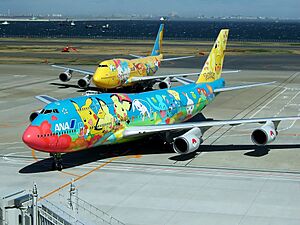
After World War II, Japan became known for its consumer products like radios and cars. In the 1990s, Japan became a source of "cool" cultural goods. Pokémon's success was a big breakthrough in the US, a country known for Disney. Pokémon helped Japan's economy and improved its soft power (cultural influence). Many children who liked Pokémon became interested in Japan and its culture.
The Pokémon TV series and films helped anime become more popular worldwide. For many children, Pokémon was their first introduction to Japanese animation. It opened the door to other anime, manga, and Japanese culture. Pokémon: The First Movie became one of the most successful Japanese animated films ever.
In video games, the main Pokémon series set the standard for "monster-taming games." Even though it wasn't the first, Pokémon became so famous that other games about catching and training monsters were compared to it.
Pokémon's success also encouraged companies to bring other popular Japanese series to Western markets. This included Yu-Gi-Oh!, Digimon, and Monster Rancher.
See also
 In Spanish: Pokémon para niños
In Spanish: Pokémon para niños


